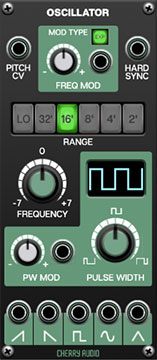The Cherry Audio "standard" oscillator is a full-featured classic analog-synthesis oscillator. It generates all standard synthesis waveforms and can be used as an audio source, or as a control voltage (CV) modulation source. Its waveform outputs are always “on”; you’ll need to use a mixer or amplifier (VCA) of some sort to start and stop its sound.
Inputs, Outputs, and Controls
Pitch CV jack- Accepts a CV input for pitch. Typically this would come from the PITCH jack in the IO Panel CV OUT section, or from a sequencer pitch CV out.
Frequency Mod attenuator, input jack- This is used for externally modulating the oscillator frequency. It's useful for adding vibrato with an LFO, siren noises, envelope-controlled pitch sweeps, etc.
Mod Type- The Mod Type button lets you select linear or exponential modulation. We'll give a couple of examples to clarify how they work:
Exponential- For a given mod input voltage, the mod amount increases as frequency increases. For example, if the base frequency is 1000 Hz, and a bipolar wave is applied to the mod CV input, the cutoff frequency rises to 2000 Hz, and falls to 500 Hz. Because audio frequencies are inherently exponential in nature, the resulting cutoff frequency rises and falls exactly one octave.
(This is why expo mod is generally used for oscillator mod - so that vibrato will rise and fall an equal amount above and below the pitch center.)Linear- For a given mod input voltage, the mod amount stays the same as frequency increases (hence the "linear" name). For example, if the base frequency is 1000 Hz, and a bipolar wave is applied to the mod CV input, the frequency rises to 1500 Hz, and fall to 500Hz. In other words, the frequency rises and falls by the same number of Hz in either direction.
If the intent of the modulation is a vibrato or siren effect, linear mod is likely the wrong choice, because the audible effect will appear to be greater in one direction than the other - in this case, expo mod would be the best choice.
So when would we use linear mod? The advantage of linear mod is that it stays constant regardless of the base frequency, which makes it useful for audio-range modulation (i.e. mod frequencies 20 Hz and faster) when the mod source is to alter tone color. In use, you'll find that expo mod allows notes and scales to play in tune, whereas expo mod in the audio range allow neat ring mod-style sound effects, but doesn't usually allow properly pitched half-step scales.
Hard Sync- Force resets the start of the waveform to the beginning of its cycle. Most often used to create the "sync sweep" oscillator sounds made famous in The Cars' "Let's Go" (or Kraftwerk's "Neon Lights" and No Doubt's "Just A Girl"), by routing the output of a second oscillator to the Hard Sync input and sweeping the pitch of the first oscillator.
Hard Sync is also useful when creating drum and percussion sounds to ensure that the wave starts at the beginning of its cycle. Finally, hard water in your sink is a totally different issue that can be remedied with a water softener.
Range- Sets the basic pitch of the oscillator, displayed in traditional organ footage. LO will be beneath the audible range and allows the oscillator to be used as a mod source.
Frequency- Fine-tune control for pitch. This can be used to fatten up multi-oscillator patches by detuning a small amount, or for "building-in" a set interval. Its range is a smidge over a fifth, up or down.
Pulse Width- This sets the width or "duty-cycle" of the pulse wave. It has no effect on any other waveform. Its default setting of 50% outputs a perfect square wave, rich in delicious odd-order harmonics. Moving the knob left or right narrows its width as well as the thickness of sound until it almost disappears at its extremes, and we’ve included a nifty “faux-OLED” display to indicate the current pulse width.
PWM Amount attenuator and PWM Mod input jack- You may have noticed that moving the Pulse Width knob back and forth creates a nifty sound; instead of wearing our your mouse hand, the PWM Mod input can be used in conjunction with an LFO, envelope generator, or other mod source to continuously vary the pulse width. Best of all, the OLED display looks real cool swooping back and forth.
Waveform Output Jacks- These are output jacks for ramp, sawtooth, pulse, sine, and triangle waves. These can be used simultaneously, in any combination.
